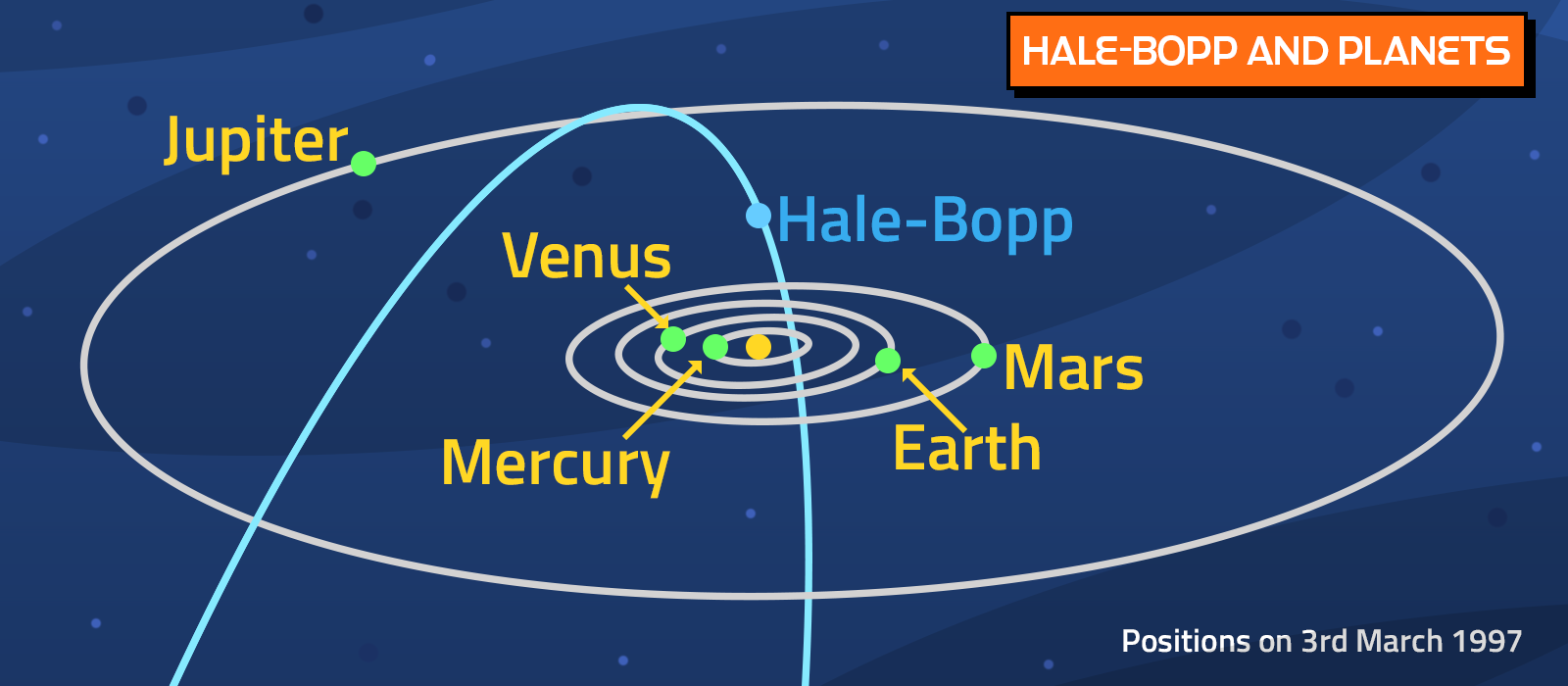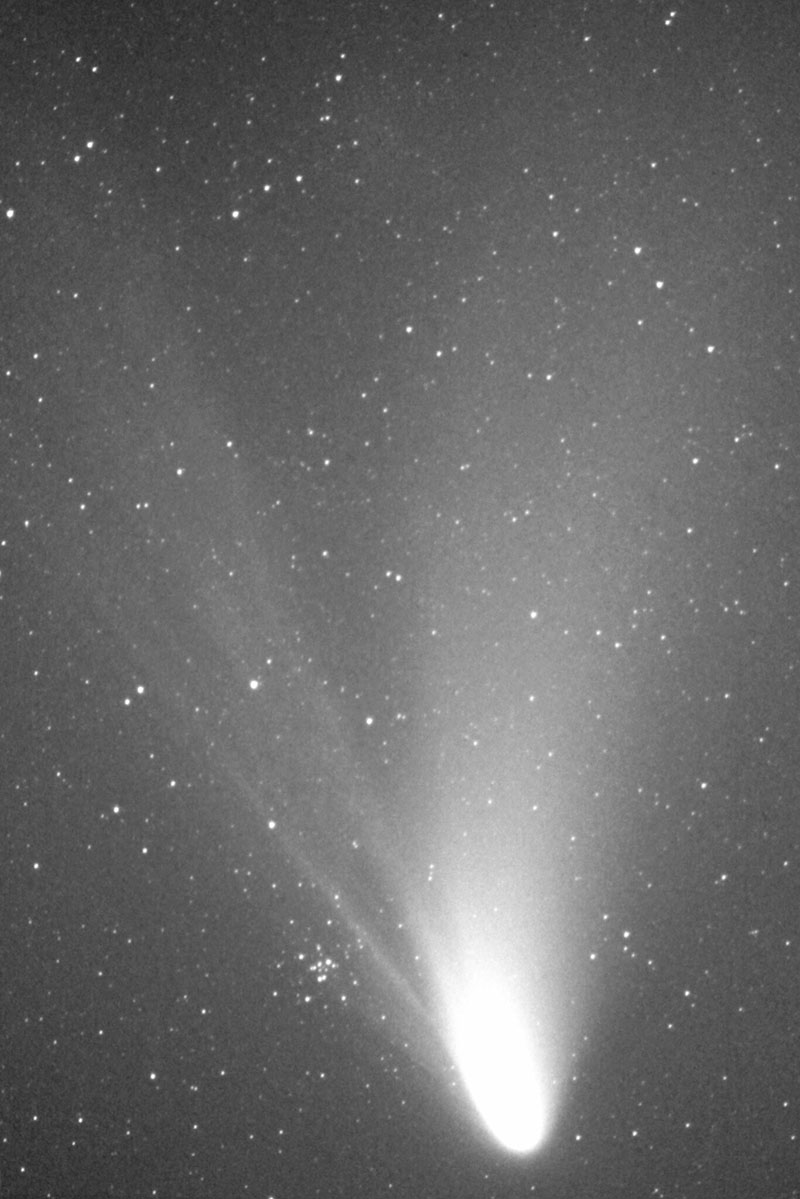Comet Hale-Bopp
Hale-Bopp is a comet that was discovered in 1995 by American astronomers Alan Hale and Tom Bopp independently of each other. It was a very bright comet and was easily visible from Earth for several months in 1996 and 1997. It is a long period comet and isn't likely to return until the year 4385. It is a much larger comet than most and has a nucleus of 60 kilometres (37 miles). The comet is also known as C/1995 O1.
There are thought to be millions, perhaps even billions, of comets in the solar system. Most are believed to orbit in a area of icy objects beyond Neptune called the Kuiper Belt, or even further out in the Oort Cloud. This is where they formed in the solar system's earliest days. Several comets break out of these areas and travel inwards through the solar system. When they approach the Sun, they begin to glow as they form a coma and distinctive tails. Almost 4,000 comets are so far known to exist.
The trouble with comets is that they are very small and very dark so they only get discovered when they get close enough to Earth to become visible. As Comet Hale-Bopp is such a large comet, it was discovered while it was still a long way away from Earth, almost two years before it made its closest approach. The discovery took place on a summer's night in 1995.
On 23rd July 1995 in New Mexico, USA, astronomer Alan Hale was observing comets from his driveway. He was looking at ones that had already been discovered but while doing so, he spotted an object that wasn't listed anywhere. After observing the movements of the mystery object, he decided that it may be a comet and notified the Central Bureau for Astronomical Telegrams. At around the same time, Tom Bopp, who was an amateur astronomer, was at a star party with friends in Phoenix, Arizona. Taking it in turns to look at clusters of stars through a telescope belonging to one of his friends, Bopp happened to spot an object near to one of the clusters. Neither he nor his friends knew what it was, so they tracked its movements and again came to the conclusion that it might be a comet. Like Hale, Bopp contacted the Central Bureau for Astronomical Telegrams to let them know of his discovery. The following day, it was confirmed that the new object was a comet and it was named after both astronomers. Up until then, Mr Hale and Mr Bopp didn't even know each other!

At the time of its discovery, Comet Hale-Bopp was about as far away from Earth as Jupiter is. Usually at that distance, comets are too distant to be easily discovered, especially with everyday telescopes. Because Hale-Bopp was discovered when it was so far away from Earth, there was a great deal of anticipation that when it got closer, it would be very bright. Halley's Comet, which last visited in 1986, has a nucleus of 15 kilometres. The nucleus of Hale Bopp is 37 kilometres, much larger than most comets.

Comet Hale-Bopp first became visible to the naked eye from around May 1996 although it was still very faint. In early 1997, as it got closer to Earth and the Sun, it became a spectacular sight and was very easy to spot in the night sky. Its closest distance to Earth was on 22nd March 1997, when it was at a distance of 197 million kilometres. This is actually further away than the Sun is from Earth, but the fact that such a small object can be so far away but still visible shows how bright comets can get. Hale-Bopp reached its closest point in its orbit of the Sun on 1st April 1997. This point is called its perihelion. At perihelion, Hale-Bopp was 137 million kilometres from the Sun. It faded out of view as the year progressed with the final sightings being reported in December 1997, almost nineteen months after its first sightings. No other comet has been recorded to have been visible with the naked eye for longer. It can still be tracked using advanced space telescopes.
Hale-Bopp was very much a comet of the early internet era. The official Hale-Bopp wepbage became the first NASA page to get over 1 million visits in a day. It's still online if you fancy a trip back in time!
Comet Hale-Bopp is a long period comet. A long period comet is any comet that that has an orbit of over 200 years. They are thought to originate in the Oort Cloud, an extremely distant region of billions of comets that surrounds the solar system. The Oort Cloud is so far away from the Sun that objects in it can be disturbed by other stars, and this is the likely cause of some of them falling towards the centre of the solar system. Comets can take thousands, even millions, of years to travel the distance to and from the Oort cloud. Scientists think that Hale-Bopp may so far have only made two orbits of the Sun. The first was around 4,200 years ago in 2215 BC. The second was the one in 1997. Hale-Bopp It is unlikely to return to Earth for around 2,300 years and won't be visible again until the year 4385. It is thought that its orbital period has been shortened from 4,200 years to 2,300 years because of the gravitational influence of Jupiter.
A group of people calling themselves Heaven's Gate believed that accompanying Comet Hale-Bopp was a spaceship which had been sent to whisk them away from Earth and take them to the Heavens, or the Next Level as they sometimes called it. This is likely the result of somebody mistaking a star near to Hale-Bopp in a photograph for a spaceship. For whatever reason, they believed that their human form on Earth was only temporary and that they they could exist forever as extraterrestrials in the Next Level if they gave up their lives on Earth and allowed their souls to be taken by the alien spacecraft following Hale-Bopp.

A photograph of Comet Hale-Bopp has been sent to the Moon. This was onboard the Lunar Prospector spacecraft, a mission to orbit the Moon that launched in January 1998. It was as part of a tribute to Eugene Shoemaker who co-discovered another famous comet, Shoemaker-Levy 9. His wife Carolyn Shoemaker and their friend David Levy were the other discoverers of it. Eugene Shoemaker died in 1997, weeks after Hale-Bopp's appearance. As Comet Hale-Bopp was the last comet that Carolyn and Eugene observed together, it was seen as fitting that photographs of it were taken onboard Lunar Prospector, alongside some of Eugene Shoemaker's ashes. At the end of its mission in July 1999, Lunar Prospector was sent to impact the Moon in a crater also called Shoemaker. Eugene Shoemaker is the first person to have a space burial on the Moon.





